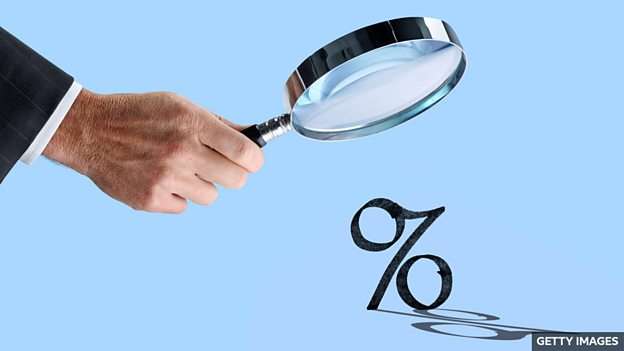内容简介
在表达 “百分比” 这个概念时,“percent(百分之…)” 和 “percentage(百分比)” 是两个十分常用的单词。百分号 “%” 在英语中应该怎么念?“上升或下降了百分之五” 应该用 “to 5%” 还是 “by 5%” 来描述?本期节目中,主持人步理和 Georgie 就来讲解和 “百分比” 这个概念有关的英语单词和表达。
文字稿
(关于台词的备注: 请注意这不是广播节目的逐字稿件。本文稿可能没有体现录制、编辑过程中对节目做出的改变。)
Buli
大家好,欢迎收听 BBC 英语教学的 “你问我答” 节目。I'm Buli.
Georgie
And I'm Georgie. We've got questions about percentages here from one of our listeners.
Question
“10% 的增长” 为什么是 “a 10% increase” 而不是 “a 10% of increase”?“Percent” 与 “percentage” 有什么区别?如何正确使用与百分比相关的表达?
Georgie
Great questions! Let's break them down one by one. Starting with 'a 10% increase'. This is the correct phrase because 'an increase' is a noun which is then modified by the percentage – in this case 10%. This would work with any adjective, for example 'a large increase'.
Buli
是的。在 “a 10% increase(百分之十的增长)” 这个表达中,“an increase(增长)” 是一个名词短语,而 “10%” 在此处充当形容词,起修饰 “increase” 的作用。之所以不能说 “a 10% of increase”,是因为介词 “of” 通常引导介词短语,修饰 “of” 前的句子成分;但在这个表达中实际上是由 “10%” 来修饰 “increase” 而非相反,因此产生了冲突。如果我们要使用介词 “of” 来表达相同的意思,可以说 “an increase of 10%”。
Georgie
In English, you're more likely to hear 'a 10% increase' because it's quicker to say. Let's hear those in context.
Examples
There was a 10% increase in sales last month because of the holiday season.
(受假期影响,上个月的销量有百分之十的增长。)
There was an increase of 10% in sales last month because of the holiday season.
(受假期影响,上个月的销量有百分之十的增长。)
Georgie
Next, what's the difference between 'percent' and 'percentage'? Percent and percentage have quite a clear distinction, don't they?
Buli
没错。百分号 “%” 就可以读作 “percent”,它的意思是 “百分之……”,通常需要接在一个具体的数字后面,比如 “10 percent(百分之十)”;而 “percentage” 是一个名词,意思是 “百分比”,指的是 “一定比例的某物”,通常不具有一个具体的数值,比如 “a large percentage(一个很大的比例或部分)”。
Georgie
OK, so when there's a number, use percent, or the symbol for percent (%). When there isn't a number, use percentage. Let's hear some more examples.
Examples
70 percent of students passed the test.
(百分之七十的学生通过了考试。)
A high percentage of students passed the test.
(通过了考试的学生比例很高。)
Buli
让我们再来看看如何准确地表达和 “百分比” 相关的概念,尤其是如何使用相关介词。比如,当我们想要表达 “上升或下降了某个百分比” 时,通常用介词 “by”。
Georgie
Yes, 'by' shows the amount of change, whereas we use 'to' to show a new total after a change. It shows a final value after an increase or decrease. Time for some examples.
Examples
This year, the percentage of students passing exams increased by 15%. 15% more students passed this year compared to last year.
(今年通过考试的学生比例增加了百分之十五。和去年相比,今年通过考试的学生数量增加了百分之十五。)
This year, the percentage of students passing exams increased to 80%. 80% of students passed.
(今年通过考试的学生比例上升到了百分之八十。百分之八十的学生通过了考试。)
Buli
上面的例子向我们展示了 “by” 和 “to” 在表达数量变化时的不同含义。“By 80%” 的意思是 “改变了百分之八十”,而 “to 80%” 的意思则是 “变成了百分之八十”。同时我们还可以注意到,“o-f, of” 可以引导用于修饰量词的介词短语,意思是 “某物中的百分之多少”,比如 “80% of students(百分之八十的学生)”。
Georgie
And we use 'off' with 'o-f-f' when we talk about sale discounts. For example, there's a sale at my favourite shop – everything is 50% off!
Buli
That can save you a good percentage of your money! 最后让我们来复习一下本期节目的主要内容。
在 “a 10% increase(百分之十的增长)” 这个短语中,“10%” 是修饰 “increase” 的形容词,因此不需要添加介词 “of”;我们也可以用 “an increase of 10%” 来表达相同的含义。当需要表示一个具体的百分比时,应该用 “number + percent(百分之……)”,比如 “a hundred percent(百分之百)”;而当想要表达一个模糊或大概的比例时,就需要用 “percentage(百分比,一定比例或部分)”,比如 “a low percentage(一个很小的比例或部分)”。
在表达和百分比有关的概念时,要注意区分以下三个不同的介词:“by…” 用于表达 “发生了多少的变化”;“to…” 用于表达 “变为了多少”;“a percentage of something” 通常表示 “某物中的百分之多少”;最后,“o-f-f” 三个字母组成的 “off” 可以用在一个百分比后面,表示 “降价了……”。
Georgie
Remember, if you have a question about the English language you'd like to ask us, please send us an email. Our email address is: questions.chinaelt@bbc.co.uk
Buli
你也可以通过微博向我们提问,我们的微博账号是 “BBC英语教学”。Bye everyone!
Georgie
Goodbye!

